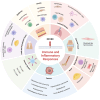CD109, a master regulator of inflammatory responses
- PMID: 39990858
- PMCID: PMC11842317
- DOI: 10.3389/fimmu.2024.1505008
CD109, a master regulator of inflammatory responses
Abstract
Inflammation is a complex response to harmful stimuli, crucial for immunity, and linked to chronic diseases and cancer, with TGF-β and NF-κB pathways as key regulators. CD109 is a glycosylphosphatidylinositol (GPI)-anchored protein, that our group has originally identified as a TGF-β co-receptor and inhibitor of TGF-β signaling. CD109 modulates TGF-β and NF-κB pathways, to influence immune responses and inflammation. CD109's multifaceted role in inflammation spans various tissue types, including the skin, lung, bone and bone-related tissues, and various types of cancers. CD109 exerts its effects by modulating processes such as cytokine secretion, immune cell recruitment, macrophage polarization, T helper cell function and cancer cell phenotype and function. Here, we review CD109's regulatory functions in inflammatory responses in these various tissues and cell types. Exploration of CD109's mechanisms of action will enhance our understanding of its contributions to disease pathology and its potential for therapeutic applications.
Keywords: CD109; NF-κB signaling; TGF-β signaling; inflammatory response; pathway crosstalk.
Copyright © 2025 Batal, Garousi, Finnson and Philip.
Conflict of interest statement
The authors declare that the research was conducted in the absence of any commercial or financial relationships that could be construed as a potential conflict of interest. The author(s) declared that they were an editorial board member of Frontiers, at the time of submission. This had no impact on the peer review process and the final decision.
Figures


References
Publication types
MeSH terms
Substances
LinkOut - more resources
Full Text Sources

